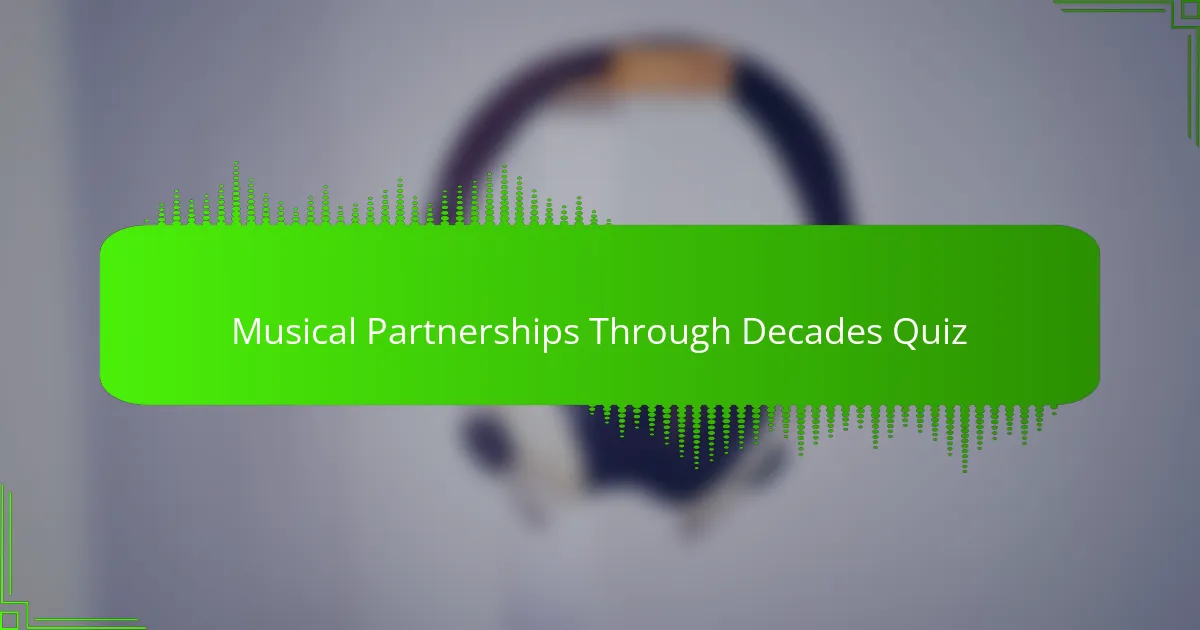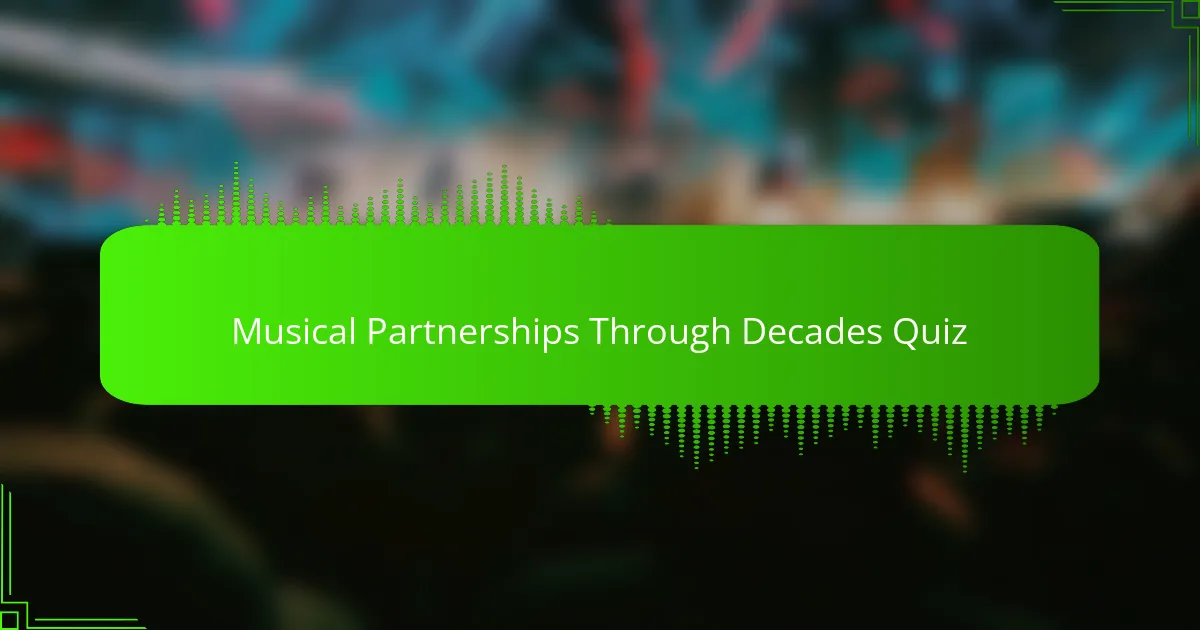
Congratulations! You’ve Completed the Quiz
Thank you for participating in our quiz on ‘Musical Partnerships Through Decades.’ We hope you found it engaging and informative. Exploring the collaborative efforts of musicians over time not only showcases their creativity but also highlights how these partnerships have shaped the music landscape. Each answer brought you closer to understanding the impact of these alliances on various genres and trends.
Throughout the quiz, you likely discovered fascinating facts about legendary duos and groups. For instance, you may have learned how their collaborations influenced cultural movements and inspired generations of artists. Such insights reveal the significance of teamwork in music creation and demonstrate how diverse influences converge to generate something beautiful.
We invite you to dive deeper into this captivating topic. Check out the next section on our page dedicated to ‘Musical Partnerships Through Decades.’ There, you’ll find detailed articles, interviews, and analyses that expand on what you’ve just explored. Continue your journey through the rich history of music with us!

Musical Partnerships Through Decades
The Evolution of Musical Duos in the 20th Century
Musical duos like Simon & Garfunkel and The Everly Brothers have significantly influenced pop and rock music throughout the 20th century. They crafted harmonies that became iconic and set benchmarks for collaborations. Their work not only defined a musical era but also shaped the sound of contemporary music. Simon & Garfunkel’s album “Bridge Over Troubled Water,” released in 1970, symbolizes the peak of their partnership, showcasing their profound lyrical ability and vocal synergy.
Notable Collaborations Between Genres in the 1980s
The 1980s saw genre-blending collaborations that pushed musical boundaries. Notably, the partnership between Run-D.M.C. and Aerosmith revitalized both rock and hip-hop with their rendition of “Walk This Way.” This collaboration introduced hip-hop to mainstream audiences, illustrating how partnerships can transcend genre limitations. The success of the song on Billboard charts exemplified the powerful fusion of two distinct musical styles.
The Rise of Collaborations in the 1990s Pop Scene
The 1990s were marked by collaborations that dominated the pop scene. A defining moment was the partnership between Whitney Houston and Mariah Carey in “When You Believe.” Their combined vocal prowess not only showcased their individual talents but also brought together fan bases, generating significant commercial success. The single won an Academy Award for Best Original Song, highlighting the impact of collaborative efforts in creating memorable and successful music.
Impactful Partnerships in the Indie Music Movement
Indie musicians, particularly in the 2000s, have formed powerful partnerships that support artistic freedom. The collaboration between The Postal Service and Death Cab for Cutie’s Ben Gibbard created a unique sound that illustrated the ethos of indie music. Their work in “Such Great Heights” resonated with audiences and demonstrated how partnerships could nurture creativity. This synergy contributed to a burgeoning indie scene that prioritized innovation over commercialism.
Modern Collaborations Shaping Today’s Music Landscape
Today’s music landscape is defined by collaborations that merge diverse influences. The partnership between Billie Eilish and her brother Finneas O’Connell showcases how familial bonds can enhance artistic expression. They co-wrote and produced hits like “Bad Guy,” which topped various charts globally. Their collaboration exemplifies the successful formula of combining distinct talents to craft innovative and relatable music. This ongoing partnership continues to influence emerging artists and redefine mainstream music.
What are some notable musical partnerships that emerged in the 1960s?
Notable musical partnerships from the 1960s include The Beatles, consisting of John Lennon and Paul McCartney, and Simon & Garfunkel, featuring Paul Simon and Art Garfunkel. The Beatles revolutionized popular music with their innovative songwriting and studio techniques, achieving 20 number-one hits on the Billboard Hot 100. Simon & Garfunkel gained acclaim with their harmonized vocals and introspective lyrics, producing classics like “The Sound of Silence” and “Bridge Over Troubled Water.” Their collaborations greatly influenced the music landscape and left a lasting legacy.
How did musical partnerships evolve in the 1970s?
In the 1970s, musical partnerships evolved through collaborations that blended various genres and showcased individual artistry. Notable examples include Elton John and Bernie Taupin, who wrote iconic songs like “Your Song,” and Fleetwood Mac, whose lineup included Lindsey Buckingham and Stevie Nicks, driving the success of the album “Rumours,” which sold over 40 million copies worldwide. This decade marked a shift towards more personal and experimental music, encouraging musicians to explore diverse sounds and themes.
Where can one find detailed accounts of musical partnerships from different decades?
Detailed accounts of musical partnerships across decades can be found in online music magazines such as Rolling Stone and Pitchfork. These publications regularly feature articles, interviews, and retrospectives that explore the dynamics of notable collaborations in music history. They provide archival content and analysis, helping readers understand the influence of these partnerships on the music industry and culture.
When did collaborations between artists begin to significantly impact popular music?
Collaborations between artists began significantly impacting popular music during the 1950s and 1960s, particularly with the rise of rock and roll. Artists like Buddy Holly and The Everly Brothers showcased the power of collaboration through their songwriting and harmonization. By the late 1960s, groups like The Beatles exemplified how partnerships could redefine music, leading to widespread acclaim and influence that shaped subsequent genres and artist collaborations.
Who were some successful musical partnerships of the 1980s?
Successful musical partnerships of the 1980s include Madonna and Stephen Bray, who co-wrote many of her early hits, and the duo of Daryl Hall and John Oates, known for their R&B-infused pop sound. Hall and Oates achieved success with chart-toppers like “Rich Girl” and “Kiss on My List,” solidifying their status as one of the best-selling music duos of all time, with over 40 million albums sold. These partnerships contributed significantly to the defining sound of the decade.

